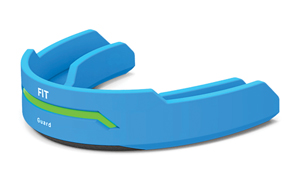Force Impact Technologies , an enterprise at ASU’s SkySong supported by the accelerator Edson Student Entrepreneur Initiative, entered the expanding field of wearable technology a little over a year ago with its FITGuard mouthpiece. An item of sports equipment, it combines an accelerometer that measures how fast something starts and stops and a gyroscope that measures how fast it spins. The information is stored on the device and transferred via bluetooth to a smartphone. Anthony Gonzales, co-founder with fellow W. P. Carey alum Bob Merriman, says their intent is “to produce hardware that will allow us to collect data” so that the information can be used “to improve the sport, make it safer, or just better understand the level of risk people are exposing themselves to in various situations.” Hoping to expand the company and use the FitGuard technology in knee braces, cleats and other sports equipment, they recently launched a crowdfunding effort.
, an enterprise at ASU’s SkySong supported by the accelerator Edson Student Entrepreneur Initiative, entered the expanding field of wearable technology a little over a year ago with its FITGuard mouthpiece. An item of sports equipment, it combines an accelerometer that measures how fast something starts and stops and a gyroscope that measures how fast it spins. The information is stored on the device and transferred via bluetooth to a smartphone. Anthony Gonzales, co-founder with fellow W. P. Carey alum Bob Merriman, says their intent is “to produce hardware that will allow us to collect data” so that the information can be used “to improve the sport, make it safer, or just better understand the level of risk people are exposing themselves to in various situations.” Hoping to expand the company and use the FitGuard technology in knee braces, cleats and other sports equipment, they recently launched a crowdfunding effort.
Although he notes they view their company more as “big data” than “wearable tech,” Gonzales says he sees wearable technology as a transitional stage of the technology evolution. “First, we were trying to get computers to be smaller; now, more convenient.”
One of the biggest challenges in this field is in being able to rapidly prototype. “In direct correlation with making things smaller, it’s harder to build it by yourself,” Gonzales says. Cost becomes a factor. “You can’t cheaply experiment with different schematics to make sure everything functions. Once things get so small and so complex in such a small area, you have to use professional contract manufacturing.”
There are larger enterprise applications involving wearables that are not as self-contained as FITGuard. In this case, the cost issue is turned around. Pointing out that it’s all a part of the Internet of Things, a machine-to-machine technology that is far from new, Courtney Ellis, a product marketing manager for Etherios’s cloud product, says, “The options are increasing because the cost of sending cellular data is dropping.”
Solutions provider Etherios recently announced it had created the first ecosystem dedicated to increasing the use of wearables for a client company’s wellness program by enabling individuals to connect any wearable device to the company’s software program. The result is transforming wearable device data — from remote patient monitoring to fitness tracking applications — into actionable information that can, potentially, result in lower overall health insurance premiums for the employees. Ellis also cites advantages of Google Glass in jobs such as field service monitoring, where speedy and convenient access to information can make the job safer. Speaking as a software solutions provider, she notes, “You can connect things that never made sense to connect before.”













Speak Your Mind
You must be logged in to post a comment.